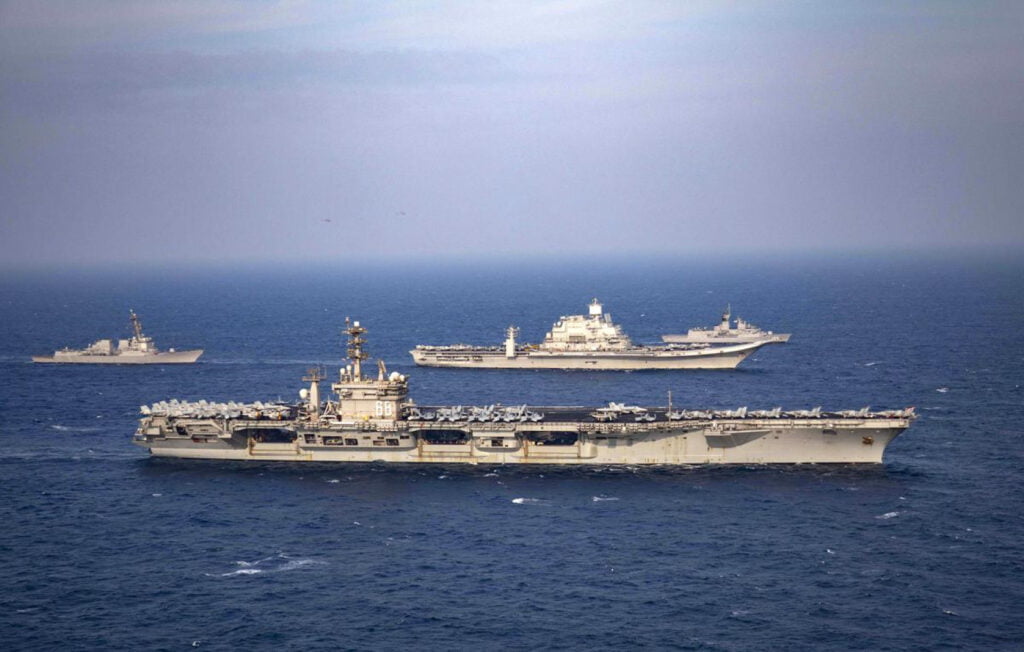The Sentinel-class U.S. Coast Guard fast response cutters USCGC Robert Goldman (WPC 1142) and USCGC Clarence Sutphin Jr. (WPC 1146) teamed with Kuwait Coast Guard fast patrol boat Wadhah (P 316), Kuwait Coast Guard speed boat (400), Kuwait Navy supply ship KNS Al-dorrar, Kuwait Navy patrol boat KNS Failaka, Kuwait Navy coastal patrol boat KNS Bateel 3 and KNS Bateel 4, a Kuwait helicopter, Iraq Navy patrol boat PB-307 and Iraq Navy patrol boat PB-310 to conduct joint patrols focused on visit, board, search, and seizure (VBSS) procedures, small boat operations, fishermen safety, and communication equipment checks, among many maritime security concerns.
This exercise builds upon previous VBSS engagement training by introducing simulated target vessels, increased VBSS drill repetitions and, as a first, conducting VBSS exercises aboard Kuwaiti ships.
Six years ago, the trilateral exercise concept was driven by the three partner nations’ desire to cooperatively address maritime security concerns in the Arabian Gulf. Since that time, the exercises have grown in complexity and are more focused on regional needs.
“Part of what makes this exercise valuable is the ability to take advantage of the wide breadth of knowledge, experience and VBSS tactics together,” said Lt. Hunter Stowes, Goldman’s commanding officer. “Exercises like this continues to strengthen our regional partnerships, maintain and improve upon our ability to integrate seamlessly with our allies and improve our skill sets in the maritime domain.”
“Kuwaiti naval forces cooperate and coordinate with regional navies to ensure maritime security in the Northern Arabian Gulf,” said Major Gen. Haza AlAlati, Commander Kuwait Naval Force.
“Our exercises, working alongside U.S. 5th Fleet, Kuwait and Iraq Navies, ensure the security and safety of the fisherman in the international waters in the Northern Arabian Gulf,” said Major Gen. Talal Almuwanes, Commander Kuwait Coast Guard.
“The aim of this exercise is to enhance skills, develop training capabilities, maintain preparedness and readiness, exchange experiences between the participating forces, and strengthen international relations within the framework of cooperation and coordination for joint action,” said Major Gen. Laith Abdul Sattar Abdul Jabbar, Iraq Um Qaser Naval Base commander.
Vice Adm. Brad Cooper, Commander U.S. Naval Forces Central Command/U.S. 5th Fleet, said the exercises demonstrate the flexibility of regional forces to adapt to changing environments.
“With this latest iteration, we are continuing to advance interoperability at sea,” he said. “It’s an honor to continue this series of exercises with our Kuwaiti and Iraqi friends. This trilateral exercise proves once again that when we work together we achieve so much more. Maritime security in the Northern Arabian Gulf is critical to regional maritime security, reinforcing the value and importance of these exercises with Kuwait and Iraq.”
U.S. Naval Forces Central Command/U.S. 5th Fleet’s area of operations (AOO) encompasses about 2.5 million square miles of water area and includes the Arabian Gulf, Red Sea, Gulf of Oman, Gulf of Aden, Arabian Sea and parts of the Indian Ocean. This expanse, comprised of 21 nations, includes three critical choke points at the Strait of Hormuz, the Suez Canal and the Strait of Bab al Mandeb.
Source : America Navy


